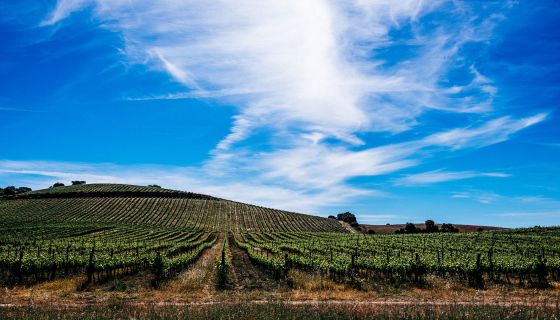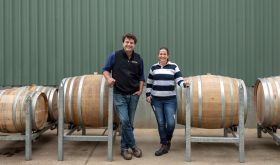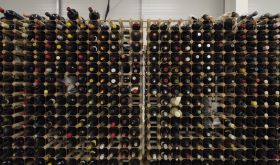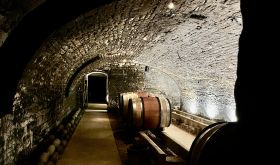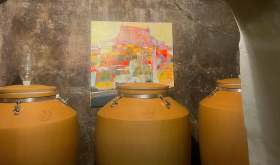We never get tired of Portuguese wines at JancisRobinson.com. With 250 officially registered grape varieties plus plenty still-mysterious ones, and landscapes that run from cool, damp, deeply green Atlantic coast to dry, torridly hot, vertiginously steep Douro Valley slopes, with every conceivable variation in between, there’s an extraordinary amount of diversity in this relatively small chunk of the Iberian Peninsula.
That’s why, even after a week in which Julia Harding MW, our resident Portuguese wine expert, reviewed some 178 newly released Portuguese wines (see the whites and rosés here and the reds and fortifieds here), we have one more to share. It’s spectacular value, available in 52 countries, and it also illustrates something often overlooked: Portugal’s white wines can be as excellent as their well-respected reds.
I don’t mean to cast aspersions on Vinho Verde – there are crisp, mineral white wines from Portugal’s north than can go head-to-head with the finest Muscadets or Spanish Albariños. But for the most part, Portugal is associated with reds. The warmth and sunniness that lends itself to juicy reds can sap the life out of white wines, leaving them flabby and dull. It takes a producer who’s focused on farming for white wines to make a great one – which is what Pedro Ribeiro does alongside his wife, Catarina Vieira, at Herdade do Rocim.
Ribeiro is from the Douro but has worked in the Alentejo since 2004, when he helped launch Herdade de Grous in Beja. He’s since made Alentejo his home base, the place where he’s run his own small winery, Bojador, focused on the region’s old vineyards and forgotten varieties, since 2010, and served as winemaker at Herdade do Rocim, his wife’s family’s winery, since 2013.
The region may not be the most obvious choice at first for an ambitious winemaker – the Alentejo is Portugal’s biggest wine region, covering about one-third of the country, and has long had a reputation for high-volume, low-priced, easy-drinking reds. But as Julia pointed out in Alentejo – countering the stereotype, if you look hard enough, you’ll find plenty of winemakers seeking out sites that allow them freshness and complexity. ‘Everyone connects [the Alentejo] with big reds’, Ribeiro agreed when I met him in NY last week, ‘but it contains many subregions, many terroirs’.
‘We’re in a unique subregion’, he continued, pointing out Vidiguera on a map. (You can find it towards the south-western end of this map from the World Atlas of Wine.) ‘Most of Alentejo is clay; in Vidiguera we have schist and granite’, he says, ‘and most of Alentejo is flat but not Vidiguera’, he continues, pointing out the Serra do Mendro to the immediate north. (Check out this interactive topographic map and note the many peaks that top out over 400 m/1,300 ft.) ‘The winds off the ocean come in and hit the serra; you essentially have an inversion, and the cool air falls back down on the vineyards – especially at harvest, there is always a mist over the vineyards.’
The schist and granite soils, cooler temperature and higher humidity lend themselves well to producing white wines, so much so, he says, that, ‘If you ask old people in the Alentejo, they will tell you white wines must be from Vidigueira – they have a freshness in white you don’t get from other regions here.’
The other key, he says, is old vines and local varieties. ‘If you respect old vineyards and use old [varieties], you can have something between power and elegance.’ He applies this standard to even his most basic wines, including Mariana, this wine of the week, what he calls ‘the first approach of what Rocim is’.
Rocim is first of all about sustaining old vineyards, and so they’ve been farming organically since 2010, and their 70 ha (173 acres) are also certified sustainable through WASP, an ambitious holistic Alentejo-wide programme. To make Mariana in quantities enough to sell widely, the blend needs to include some purchased fruit, and Ribeiro insists it’s all organically grown, too.
The wine is based on Antão Vaz – ‘some people call it Alentejo Chardonnay, as it works in both fresh and barrel styles, but in Alentejo everyone knows it works well only in Vidiguera; it’s too warm elsewhere.’ The rest of the blend is made up of Arinto (‘very important because of its acidity’) and Alvarinho (‘not usual in this region but this guy planted it thirty years ago, so this is from that thirty-year-old vineyard. It’s about 20% of the blend; it gives it aromatics’).
All the grapes are picked by hand and go into concrete tanks, where they ferment with ambient yeasts (as all of Rocim’s wines do, since 2014). The 2024 vintage was a nail-biter, Ribeiro says – ‘there was as a lot of mildew, and we lost a lot of production; in organic vineyards, it was really tough’. And early on, he confided to Julia (in Portugal harvest 2024) that he wasn’t sure if he’d picked too early. (‘If I have a signature, it’s picking early’, he admits to me.)
But tasting the wine now, I can say with 100% certainty he did not. The Mariana 2024 is bright and sunny, the rich roundness of Antão Vaz filling the mouth with apple and pear flavour, yet it’s only 12.5% alcohol, with a breezy acidity and slight floral lift that makes it as refreshing as it is flavourful. As I wrote in my tasting note, ‘It feels wholesome and satisfying, complex enough to hold its own for a quiet summer evening but with enough personality to cut through the noise of the party you might bring it to.’
Ribeiro makes a red version of Mariana, too, just as well priced and in even larger quantities, though in my opinion the white version has more elegance and personality. Still, if you’re having a steak for dinner, or a juicy beef burger, it’s a good option. Both wines are a terrific introduction to the Alentejo, and the possibilities of winemaking in its cooler, higher vineyards, as they are to Ribeiro’s careful, site-reflective winemaking.
Just be warned: they might tempt you to work your way through Rocim’s entire portfolio, which can lead you all the way up to Vinha da Micaela, a tiny production of an ancient mixed vineyard that could compete with a fine grand cru burgundy – and sells for as much, too.
Hallgarten Wines import the Herdade do Rocim, Mariana Branco 2024 into the UK, where Wine-Searcher.com lists it for as low as £11.09 per bottle; in the US, Shiverick Imports handles it, suggesting a retail price of $18.
All photos courtesy of Herdade do Rocim.
Find reviews on many, many more of Herdade do Rocim's wines in our tasting notes database, and explore the delicious possibilities of the Alentejo's white wines.

